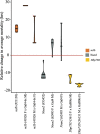Gene expression differences consistent with water loss reduction underlie desiccation tolerance of natural Drosophila populations
- PMID: 36797754
- PMCID: PMC9933328
- DOI: 10.1186/s12915-023-01530-4
Gene expression differences consistent with water loss reduction underlie desiccation tolerance of natural Drosophila populations
Abstract
Background: Climate change is one of the main factors shaping the distribution and biodiversity of organisms, among others by greatly altering water availability, thus exposing species and ecosystems to harsh desiccation conditions. However, most of the studies so far have focused on the effects of increased temperature. Integrating transcriptomics and physiology is key to advancing our knowledge on how species cope with desiccation stress, and these studies are still best accomplished in model organisms.
Results: Here, we characterized the natural variation of European D. melanogaster populations across climate zones and found that strains from arid regions were similar or more tolerant to desiccation compared with strains from temperate regions. Tolerant and sensitive strains differed not only in their transcriptomic response to stress but also in their basal expression levels. We further showed that gene expression changes in tolerant strains correlated with their physiological response to desiccation stress and with their cuticular hydrocarbon composition, and functionally validated three of the candidate genes identified. Transposable elements, which are known to influence stress response across organisms, were not found to be enriched nearby differentially expressed genes. Finally, we identified several tRNA-derived small RNA fragments that differentially targeted genes in response to desiccation stress.
Conclusions: Overall, our results showed that basal gene expression differences across individuals should be analyzed if we are to understand the genetic basis of differential stress survival. Moreover, tRNA-derived small RNA fragments appear to be relevant across stress responses and allow for the identification of stress-response genes not detected at the transcriptional level.
Keywords: Cuticular hydrocarbons; Insect physiology; Post-transcriptional regulation; Respiration rate; Water content; tRFs.
© 2023. The Author(s).
Conflict of interest statement
The authors declare that they have no competing interests.
Figures





Similar articles
-
Rapid desiccation hardening changes the cuticular hydrocarbon profile of Drosophila melanogaster.Comp Biochem Physiol A Mol Integr Physiol. 2015 Feb;180:38-42. doi: 10.1016/j.cbpa.2014.11.004. Epub 2014 Nov 9. Comp Biochem Physiol A Mol Integr Physiol. 2015. PMID: 25460832
-
Divergence of water balance mechanisms in two melanic Drosophila species from the western Himalayas.Comp Biochem Physiol A Mol Integr Physiol. 2011 Apr;158(4):531-41. doi: 10.1016/j.cbpa.2010.12.018. Epub 2011 Jan 8. Comp Biochem Physiol A Mol Integr Physiol. 2011. PMID: 21220040
-
Divergence of water balance mechanisms in two sibling species (Drosophila simulans and D. melanogaster): effects of growth temperatures.J Comp Physiol B. 2013 Apr;183(3):359-78. doi: 10.1007/s00360-012-0714-3. Epub 2012 Oct 19. J Comp Physiol B. 2013. PMID: 23080219
-
Impact of body melanisation on desiccation resistance in montane populations of D. melanogaster: Analysis of seasonal variation.J Insect Physiol. 2009 Oct;55(10):898-908. doi: 10.1016/j.jinsphys.2009.06.004. Epub 2009 Jun 25. J Insect Physiol. 2009. PMID: 19538968
-
Desiccation and starvation resistance in Drosophila: patterns of variation at the species, population and intrapopulation levels.Heredity (Edinb). 1999 Dec;83 ( Pt 6):637-43. doi: 10.1046/j.1365-2540.1999.00649.x. Heredity (Edinb). 1999. PMID: 10651907 Review.
Cited by
-
Population-scale long-read sequencing uncovers transposable elements associated with gene expression variation and adaptive signatures in Drosophila.Nat Commun. 2022 Apr 12;13(1):1948. doi: 10.1038/s41467-022-29518-8. Nat Commun. 2022. PMID: 35413957 Free PMC article.
-
Thermal Development, Mortality, and Fertility of an Apulian Strain of Drosophila suzukii at Different Temperatures.Insects. 2025 Jan 10;16(1):60. doi: 10.3390/insects16010060. Insects. 2025. PMID: 39859641 Free PMC article.
-
Cuticular hydrocarbons promote desiccation resistance by preventing transpiration in Drosophila melanogaster.J Exp Biol. 2024 Dec 1;227(23):jeb247752. doi: 10.1242/jeb.247752. Epub 2024 Nov 28. J Exp Biol. 2024. PMID: 39445981 Free PMC article.
-
Reactivation of retrotransposable elements is associated with environmental stress and ageing.Nat Rev Genet. 2025 Aug;26(8):547-558. doi: 10.1038/s41576-025-00829-y. Epub 2025 Apr 2. Nat Rev Genet. 2025. PMID: 40175591 Review.
-
From whole bodies to single cells: A guide to transcriptomic approaches for ecology and evolutionary biology.Mol Ecol. 2025 Aug;34(15):e17382. doi: 10.1111/mec.17382. Epub 2024 Jun 10. Mol Ecol. 2025. PMID: 38856653 Free PMC article. Review.
References
-
- Parmesan C. Ecological and evolutionary responses to recent climate change. Annu Rev Ecol Evol Syst. 2006;37(1):637–669.
-
- Stott P. Climate change. How climate change affects extreme weather events. Science. 2016;352(6293):1517–8. - PubMed
-
- Grillakis MG. Increase in severe and extreme soil moisture droughts for Europe under climate change. Sci Total Environ. 2019;660:1245–1255. - PubMed
Publication types
MeSH terms
Substances
Grants and funding
LinkOut - more resources
Full Text Sources
Molecular Biology Databases

